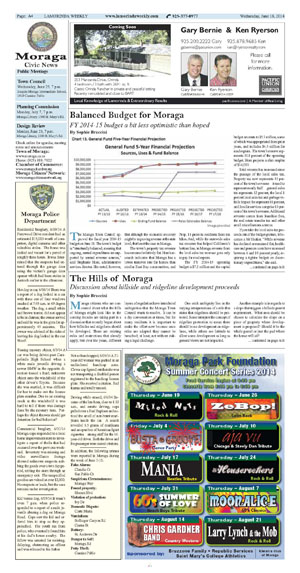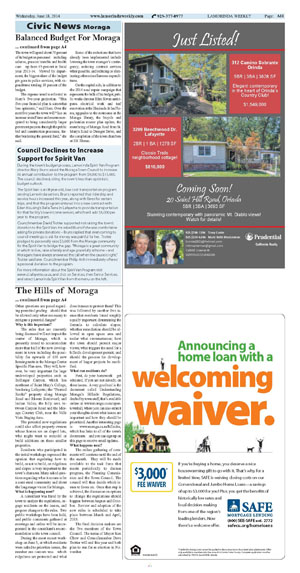|
|
Published June 18th, 2014
|
The Hills of Moraga
|
| Discussion about hillside and ridgeline development proceeds |
| By Sophie Braccini |
|
|
Moraga citizens who are concerned about what the hills of Moraga might look like in the coming decades are taking part in a discussion that recently began about how hillsides and ridgelines should be developed. There are existing rules and restrictions that already apply, but over the years, different layers of regulation have introduced ambiguities that the Moraga Town Council wants to resolve. It can be a dry conversation at times, but for many residents it is important to make the effort now because once rules are adopted they cannot be breached; at least, not without risking a legal challenge.
 One such ambiguity lies in the varying interpretations of a rule that states that ridgelines should be protected. Some interpret the concept of ridgeline protection to mean there should be no development on ridgelines, while others see latitude to allow some development as long as general views are not impacted.
One such ambiguity lies in the varying interpretations of a rule that states that ridgelines should be protected. Some interpret the concept of ridgeline protection to mean there should be no development on ridgelines, while others see latitude to allow some development as long as general views are not impacted.
 Another example is in regards to a slope that triggers a hillside permit requirement. What area should be chosen to calculate the slope on a piece of property where development is proposed? Should it be the whole parcel or just the pad where the house will sit? Other questions are posed regarding permitted grading - should that be allowed only when necessary to mitigate a potential danger?
Another example is in regards to a slope that triggers a hillside permit requirement. What area should be chosen to calculate the slope on a piece of property where development is proposed? Should it be the whole parcel or just the pad where the house will sit? Other questions are posed regarding permitted grading - should that be allowed only when necessary to mitigate a potential danger?
 Why is this important?
Why is this important?
 The rules that are currently being discussed will not impact the center of Moraga, which is presently zoned to accommodate more than half of the new development in town including the possibility for upwards of 650 new housing units in the Moraga Center Specific Plan area. They will, however, be very important for large undeveloped properties such as Bollinger Canyon, which lies northeast of Saint Mary's College, bordering Lafayette; the "Painted Rocks" property along Moraga Road and Rheem Boulevard; and Indian Valley, the hilly area between Canyon Road and the Moraga Country Club, near the Valle Vista Staging Area.
The rules that are currently being discussed will not impact the center of Moraga, which is presently zoned to accommodate more than half of the new development in town including the possibility for upwards of 650 new housing units in the Moraga Center Specific Plan area. They will, however, be very important for large undeveloped properties such as Bollinger Canyon, which lies northeast of Saint Mary's College, bordering Lafayette; the "Painted Rocks" property along Moraga Road and Rheem Boulevard; and Indian Valley, the hilly area between Canyon Road and the Moraga Country Club, near the Valle Vista Staging Area.
 The potential new regulations could also affect property owners whose homes are on sloped lots, who might want to remodel or build additions on these smaller properties.
The potential new regulations could also affect property owners whose homes are on sloped lots, who might want to remodel or build additions on these smaller properties.
 Residents who participated in the initial workshops expressed the opinion that regulating how to build, or not to build, on ridgelines and slopes is very important to the town's character. Many asked questions regarding what it means to be a semi-rural community and about the long range vision for Moraga.
Residents who participated in the initial workshops expressed the opinion that regulating how to build, or not to build, on ridgelines and slopes is very important to the town's character. Many asked questions regarding what it means to be a semi-rural community and about the long range vision for Moraga.
 What is happening now?
What is happening now?
 A consultant was hired by the town to analyze the regulations, engage residents on the issues, and propose changes to the rules. Two public workshops have been held, and public comments gathered at meetings and online will be incorporated in the consultant's recommendation to the town council.
A consultant was hired by the town to analyze the regulations, engage residents on the issues, and propose changes to the rules. Two public workshops have been held, and public comments gathered at meetings and online will be incorporated in the consultant's recommendation to the town council.
 During the most recent workshop on June 5, at which residents were asked to prioritize issues, the number one concern was - which ridgelines are protected and what does it mean to protect them? This was followed by another five issues that residents found roughly equally important: determining the formula to calculate slopes; whether remediation should be allowed in open space area and under what circumstances; how the town should protect major views; what triggers the need for a hillside development permit; and should the process for development of larger projects be modified.
During the most recent workshop on June 5, at which residents were asked to prioritize issues, the number one concern was - which ridgelines are protected and what does it mean to protect them? This was followed by another five issues that residents found roughly equally important: determining the formula to calculate slopes; whether remediation should be allowed in open space area and under what circumstances; how the town should protect major views; what triggers the need for a hillside development permit; and should the process for development of larger projects be modified.
 What can residents do?
What can residents do?
 First, do your homework - get educated, if you are not already, on these issues. A very good tool is the document called Understanding Moraga's Hillside Regulations, drafted by town staff, that's available online at www.moraga.ca.us/opentownhall, where you can also submit your thoughts about what issues are important and how they should be prioritized. Another interesting page is www.moraga.ca.us/hillsides, which has links to all of the town's documents - and you can sign up on this page to receive email updates.
First, do your homework - get educated, if you are not already, on these issues. A very good tool is the document called Understanding Moraga's Hillside Regulations, drafted by town staff, that's available online at www.moraga.ca.us/opentownhall, where you can also submit your thoughts about what issues are important and how they should be prioritized. Another interesting page is www.moraga.ca.us/hillsides, which has links to all of the town's documents - and you can sign up on this page to receive email updates.
 What happens next?
What happens next?
 The online gathering of comments will continue until the end of the month. They will be made available to the task force that meets periodically to discuss progress, the Planning Commission and the Town Council. The council will then decide which issues to focus on. Once that step is achieved, the discussion on options to change the regulations should happen between August and October. Review and adoption of the new rules is scheduled to take place between March and April, 2015.
The online gathering of comments will continue until the end of the month. They will be made available to the task force that meets periodically to discuss progress, the Planning Commission and the Town Council. The council will then decide which issues to focus on. Once that step is achieved, the discussion on options to change the regulations should happen between August and October. Review and adoption of the new rules is scheduled to take place between March and April, 2015.
 The final decision makers are the five members of the Town Council. The terms of Mayor Ken Chew and Councilmember Dave Trotter will end this year and both plan to run for re-election in November.
The final decision makers are the five members of the Town Council. The terms of Mayor Ken Chew and Councilmember Dave Trotter will end this year and both plan to run for re-election in November.

|
|
|
|
|
|
|
|
|
| |
|
|
|
|



